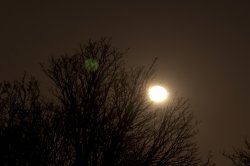So I tried my first ever night shoot yesterday. Took my tripod out around 10pm to Jericho beach in Vancouver to try and get a shot across the bay of the Vancouver skyline. I used a Nikon remote, quite a sturdy tripod and both a 10-20mm Sigma and 70-300 Nikkor for my shots. ISO 200, f/11 and ~8-15s shutter.
The results were sub-optimal.
My shots of the skyline were dark and lacked detail. I think next time I'll have to physically move closer to the skyline. All I see at this point are a bunch of light dots in the darkness. There is no appearance of buildings.
My other issue (see attached) was the moon. There was a beautiful moon out so I figured hey, at the very least I'll get some cool shots because it was peaking behind the exposed branches of a tree. Looked really cool to my eyes. Lame on the computer screen. No detail in the moon, can barely tell there are branches in most shots. Furthermore, what is that green thing? Lens flare? A fingerprint? I took the UV filter off thinking it was some kind of flare and that kind of improved it.
I read Understanding Exposure 3rd ed. and Scott Kelby's Vol. I and II. I guess just more time shooting and practicing to get "the shot"?
The results were sub-optimal.
My shots of the skyline were dark and lacked detail. I think next time I'll have to physically move closer to the skyline. All I see at this point are a bunch of light dots in the darkness. There is no appearance of buildings.
My other issue (see attached) was the moon. There was a beautiful moon out so I figured hey, at the very least I'll get some cool shots because it was peaking behind the exposed branches of a tree. Looked really cool to my eyes. Lame on the computer screen. No detail in the moon, can barely tell there are branches in most shots. Furthermore, what is that green thing? Lens flare? A fingerprint? I took the UV filter off thinking it was some kind of flare and that kind of improved it.
I read Understanding Exposure 3rd ed. and Scott Kelby's Vol. I and II. I guess just more time shooting and practicing to get "the shot"?





